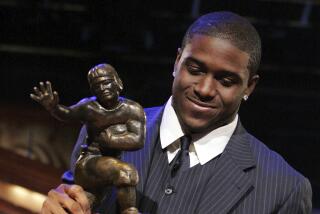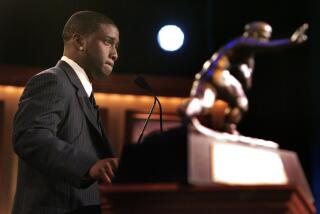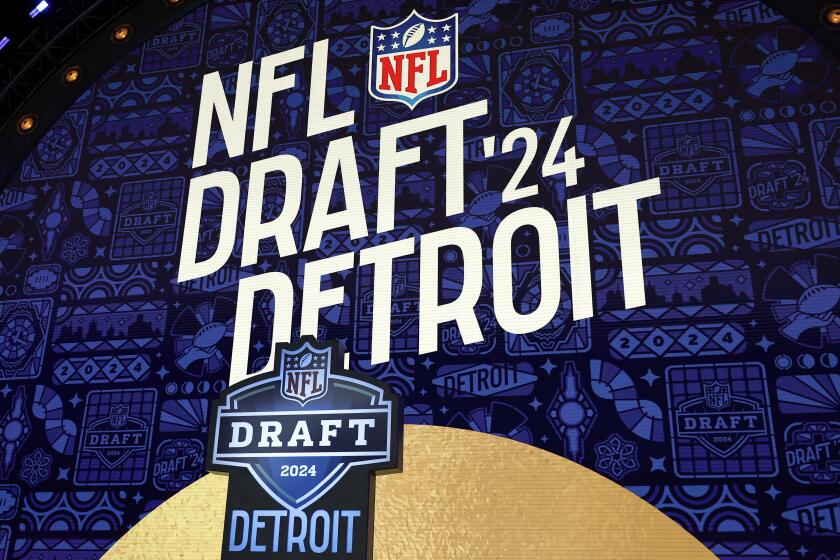Phone Calls Are So Old School
The nation’s top-rated high school kicker was in a film session this summer when his equipment bag started vibrating. It was his cellphone buzzing.
A UCLA coach had sent a text message inviting him to Westwood to watch a practice. Later, he received a text message from a Notre Dame coach asking him to call the school.
Bound by NCAA rules prohibiting them from contacting Sherman Oaks Notre Dame High senior Kai Forbath by telephone until Sept. 1, recruiters did the next best thing. They turned to text messages, instant messaging and e-mails, the very forms of technology that teenagers use to stealthily contact each other.
Given the increasing competition for top athletes, colleges across the country are upgrading coaches’ phones, purchasing new computer software and expanding databases as hand-held BlackBerrys, Treos and Sidekicks join whistles, bullhorns and dry-erase markers as indispensable accessories for today’s coaches.
“Technology has completely changed the recruiting game,” said Nathaniel Hackett, the football recruiting coordinator at Stanford. “People can get ahold of anybody from anywhere.”
Some say that’s the problem.
The NCAA has various rules limiting telephone calls, but there are no restrictions on e-mails and text messages.
The rules are designed, officials say, so that the haves and have-nots among colleges will be on relatively equal footing when it comes to recruiting. Compared to a telephone call, text and e-mail messaging were thought to be relatively inexpensive yet effective options.
Unless, of course, you are a heavily recruited teenager whose family didn’t purchase a phone plan that included unlimited text messaging.
Kelli Pedersen, whose daughter Kayla is a sought-after junior basketball player from Red Mountain High in Mesa, Ariz., said at first she got a kick out of all the attention.
“We were eating dinner and she had her phone on vibrate and it started going off at the table,” Kelli said. “She’s text messaging and it would go off again. We thought it was funny.”
The humor stopped when the family considered what its next phone bill might look like with more than two dozen coaches now text messaging Kayla. Charges are about 10 cents a message, depending on the plan.
Pedersen’s grandfather gave Kayla the cellphone as a gift and was so stunned after receiving the initial bill this month that he called the phone company because “he didn’t believe it was true,” Kayla said
The distraction of receiving so many messages is another concern.
Stafon Johnson, a star running back from Los Angeles Dorsey High, said coaches have been text messaging him as early as 6:30 in the morning and as late as 11:30 at night.
Fearing exactly such a scenario, the association that represents college women’s basketball coaches last year introduced a proposal that would have barred its members from sending e-mails and text messages to recruits.
“Our committee felt coaches were going to contact recruits at 2 in the morning or while they were in class,” said Binh Nguyen, manager of events and legislation for the Women’s Basketball Coaches Assn. “We didn’t want to inundate them while they were in high school.”
But the NCAA Management Council disagreed, rejecting the proposal in April.
Some college programs are more savvy than others. USC freshman Brian Cushing, a high school All-American linebacker last season, was the focus of an intense recruiting competition during his senior year at Bergen Catholic in New Jersey. He recalls the University of Miami sending photos of its practices to his cellphone. “Some schools know how to use technology to their advantage,” he said.
Even veteran coaches who came up in the era of rotary telephones are learning new tricks, such as Arizona basketball Coach Lute Olson and USC football Coach Pete Carroll.
Olson, 71, sent his first text message last spring. Carroll, whose team is seeking an unprecedented third consecutive national championship, said sending a text message on his cellphone is “my latest accomplishment.”
The technology is familiar, though, to the athletes.
A July survey from the Pew Internet & American Life project found that 87% of U.S. youths between the ages of 12 and 17 use the Internet, about 21 million.
While recruits use websites to study depth charts, coaches log in to recruiting networks such as Rivals.com and Scout.com and within seconds can learn a prospect’s height, weight, sprint times and accomplishments.
“Kids are computer literate,” said Josh Johnson, a UCLA recruiting assistant. “It’s a matter of whether the coaches are. Kids have grown up with computers and cellphones. We hope at least one person on each coaching staff is a point person for modern technology.”
UCLA’s 22 sports programs just last month started using software developed by Scoutware, a 3-year-old company based in Aurora, Ill. At Stanford, the football program uses CyberSports, a 10-year-old company based in New Hartford, N.Y. Considering the money university athletic programs spend on young athletes -- many scholarships are worth tens of thousands of dollars per year -- the investment is considered worth it.
“Some of the coaches who have been the most old-school and resisted the hardest have been our biggest supporters,” said Candice Hobin, vice president of CyberSports. “Because they didn’t grow up in the age of technology, they didn’t realize how much it would help them until they were trained how to do it.”
Schools are finding they have to make changes or be left behind.
“We just got different phones to get text messages and e-mails,” said Lane Kiffin, USC’s football recruiting coordinator. “I think it’s gotten out of hand, but we have to compete. A lot of football coaches don’t know how to turn on a computer, let alone e-mail.”
That’s why having a technology expert on staff has become almost mandatory. At Stanford, it’s Hackett, 25, who gets called on.
“They’re yelling, ‘Coach Hackett, come here!’ ” he said.
UCLA’s expert is men’s basketball assistant Kerry Keating, who took a photo using his cellphone from this year’s Final Four, stored it, and plans to send it out to prospective recruits with the caption, “This is where we’ll be.”
“I’m 34 going on 19,” Keating said. “There’s so much going on with these kids. I had a kid send me a photo of him holding up a 14-pound bass through instant messaging.”
The global positioning satellite system in phones and rental cars has become another helpful tool for recruiters in finding a home or high school when making visits to small towns.
“GPS is a must,” Kiffin said. “You just punch in an address.”
Soon, experts say, the NCAA will have to rule on individuals who use a headset microphone to talk over a high speed Internet connection. No telephone is used, but the NCAA currently counts it as a phone call because of the voice-to-voice interaction.
Coaches and others point out that change is happening almost daily.
“The minute one person figures something out, another does something else,” Stanford’s Hackett said. “It’s never ending.”
More to Read
Get our high school sports newsletter
Prep Rally is devoted to the SoCal high school sports experience, bringing you scores, stories and a behind-the-scenes look at what makes prep sports so popular.
You may occasionally receive promotional content from the Los Angeles Times.







